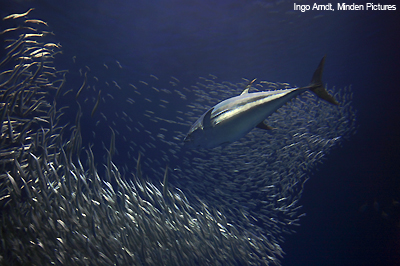Big Opportunity for Pacific Fish
Our nation's West Coast is known worldwide for the rich and iconic marine life that can be found off its shores. In fact, countless tourists travel there every year just for a glimpse of a pod of migrating gray whales or the chance to catch a coho or king salmon in the wild.

These species and a host of other Pacific marine predators need to eat plenty of small fish to survive and thrive. In fact, to understand the well-being of an ocean ecosystem, one of the first steps is to measure the food supply upon which other, larger species depend.
The Pacific Fishery Management Council (PFMC) has a chance to do just that when it meets this November to guide the completion of its Fishery Ecosystem Plan. Nobody, however, wants a document that just gathers dust on a shelf. Embracing a new policy to measure the amount of prey in the water would be a huge step forward with benefits for numerous Pacific marine predators—from whales breeding off the sunny shores of San Diego to salmon foraging in the chilly waters of the Seattle area's Puget Sound.
Small oil-rich fish such as sardines, anchovies, and smelt—commonly known as forage fish—are the linchpin of the marine ecosystem along the West Coast. They eat tiny plants and animals drifting near the surface and, in turn, become prey for everything higher on the food web.
The Pacific Fishery Management Council can't control global market trends, but it can make forage fish a priority as the key link in a productive Pacific Ocean.Lee Crockett, director, U.S. Ocean Conservation
In June, the PFMC recognized the ecological importance of these fish when it set a goal of prohibiting new commercial fishing that targets forage species until there is proof that it won't degrade the ecosystem. However, the council has delayed enacting actual protections for vulnerable forage species such as saury, sand lance, and lanternfish. Instead, the PFMC is now pursuing a slower path that requires it to complete a Fishery Ecosystem Plan by March 2013 before moving on to protect currently unmanaged forage fish. So the council needs to make sure it finishes the plan on time.
We cannot afford to delay protections for these important prey species. Our oceans are under increasing environmental stress because of chronic problems such as water pollution and degradation of coastal habitat. Unlike these and other large-scale factors affecting ocean health, the PFMC has a say about fishing that impacts the prey base along the West Coast, and its members can take proactive measures to protect these little fish.
Worldwide, forage species account for more than a third of total marine fish landings by weight, with 90 percent turned into products such as animal feeds and nutritional supplements. Commercial interest in these small, oily fish is growing more intense.
In fact, an analysis done for the PFMC noted that the market for currently unfished forage species along the West Coast is likely to become even more attractive because of the “spectacular growth” of the global aquaculture industry. In other words, the need to feed carnivorous species such as farmed salmon and pen-fattened tuna could take the food supply away from fish swimming in the wild. That means the abundance of fish that supports both commercial and sports fishing, as well as a number of other sectors of the West Coast economy, is at risk.
The Pacific Fishery Management Council can't control global market trends, but it can make forage fish a priority as the key link in a productive Pacific Ocean. The council should start by putting in place a system to measure and track the amount of prey in the water.
This article originally ran at newswatch.nationalgeographic.com.






